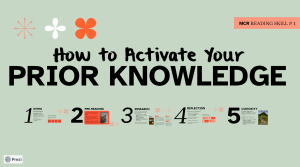17 Prior Knowledge
Learning Objectives
-
Understand the connection between reading comprehension and prior knowledge. Practice activating prior knowledge when reading.
-
Use metacognitive reading strategies before, during and after reading fiction, non-fiction and graphics.
Chapter & Discussion
This chapter includes a presentation that can be navigated in a classroom setting or independently. You can access the presentation via the link below.
Strategy One: Activating Prior Knowledge
Work through the different sections of the chapter and discuss ideas and topics as they arise. If you’re working independently, take notes instead. Notes and active discussion will be helpful in navigating this week’s assignments.
Introduction
Metacognitive reading strategies help you become a stronger reader by being self-aware of your goals and how you practice them.
The first strategy is called “Activating Your Prior Knowledge.”
Is what you already know about your book. This is probably more than you think! You can start with a few prompts like these:
- What is this book about?
- Who is the target audience?
- What do I remember about it?
- What do others have to say about it?
Pre-Reading
The process of looking ahead towards what you’ll be reading is called pre-reading.
The goal of this strategy is to help you comprehend new information by considering things you already know about the topic or text.
Connecting the reading with your prior knowledge and experience accounts for a lot of the comprehension process.

Research
Always try to find out what you can about your book before reading it. You can look into:
The information on the dust jacket or the back of the book
Reviews or videos
Check the page count
Interviews with the author
Chatting with someone who has read the book
*Note: If you discover that the book isn’t worth your time, don’t read it!
Example: Holes, by Louis Sachar
Dust Jacket
Stanley Yelnats is under a curse. A curse that began with his no-good-dirty-rotten-pig-stealing-great-great-grandfather and has since followed generations of Yelnatses. Now Stanley has been unjustly sent to a boys’ detention center, Camp Green Lake, where the boys build character by spending all day, every day digging holes exactly five feet wide and five feet deep. There is no lake at Camp Green Lake. But there are an awful lot of holes.
It doesn’t take long for Stanley to realize there’s more than character improvement going on at Camp Green Lake. The boys are digging holes because the warden is looking for something. But what could be buried under a dried-up lake? Stanley tries to dig up the truth in this inventive and darkly humorous tale of crime and punishment
—and redemption.
Praise
“[Sachar] comes fully, brilliantly into his own voice. This is a can’t-put-it-down read.” —The Bulletin
“A dazzling blend of social commentary, tall tale and magic realism.” —Publishers Weekly, Starred Review
Audience Response
I relished this story of survival, as I saw it, across stark and harsh environs. In a time when survival has become almost too ‘basic’ to be grateful for, I loved reading as this book affirmed the importance of a routine, of gratitude, of knowing how to play your cards, acknowledging when fate guides you.
Reflection
Once you’ve researched your book, it’s important to reflect on how it connects with your prior knowledge.
What do you know about the book’s subject matter?
What does it remind you of?
How does it connect with your experiences?

Curiosity
The last step is to activate your curiosity. When we learn, it’s through practice, and it’s driven by curiosity.
Ask yourself questions about your reading:
How does this connect to my skills, interests, or passions?
What types of books or genres have sparked my interest in the past?
Who do I want to talk with about this book?
Assigned Reading
Here are this week’s readings. Additionally, please read for your own personal enjoyment for 1/2 hour each day. This will be called your “Reading Zone” reading and it will coincide with many upcoming activities.
What is Intelligence? Where Does it Begin? by Kurzgesagt- In a Nutshell
Problem Set: Practice Your Skills!
Click here to complete a ten-question problem set on concepts in this chapter.
Completing problem sets like this can be an important element of independent study towards completing your HSE. I write these to resemble the style of questions you’ll find on the Reading and Language Arts GED.
Assignment: Dust Jacket (250 Words)
Look at the dust jacket of your Reading Zone book. Using the same format, write a dust jacket for a story about you. This could be a fictional story or your real life story. Include the following elements:
-
A synopsis of the story that gives us plot and background information
-
A cliffhanger
-
Praise from famous authors or celebrities
-
An audience review
Assignment: Reading Zone Response (250 Words)
For Reading Zone, you must find a novel that is interesting to you and enjoyable to read. If you need help finding a Reading Zone book, please ask. Please read your Reading Zone book for a half-hour each day. On class days, there will be time in class dedicated to reading.
Create a two-paragraph response to the reading you did this week. The first paragraph should summarize what you read this week. The second paragraph should address the following prompt:
What did you already know about your reading zone book? What did you know about the topics it explores? What does this book remind you of? How does it connect to your curiosities, interests, or passions?
Attributions
Duke, N. K., & Pearson, P. D. (2002). Effective practices for developing reading comprehension. In A. E. Farstrup & S. J. Samuels (Eds.), What research has to say about reading instruction (3rd ed) (pp. 205-242). Newark, DE: International Reading Association. Reprinted in Journal of Education, 189, 107-122.
Mills, Kathy A. (2008) The Seven Habits of Highly Effective Readers. In Proceedings Stories, Places, Spaces: Literacy and Identity, National conference by the Australian Literacy Educators’ Association (ALEA) and Australian Association for the Teaching of English, Adelaide, SA.


